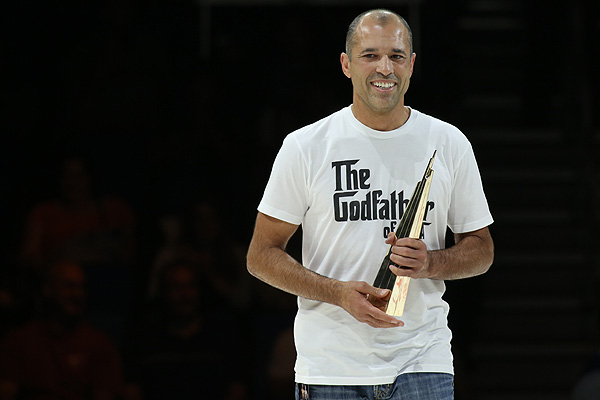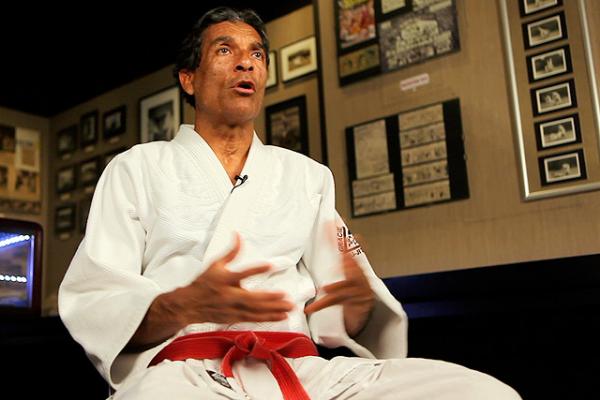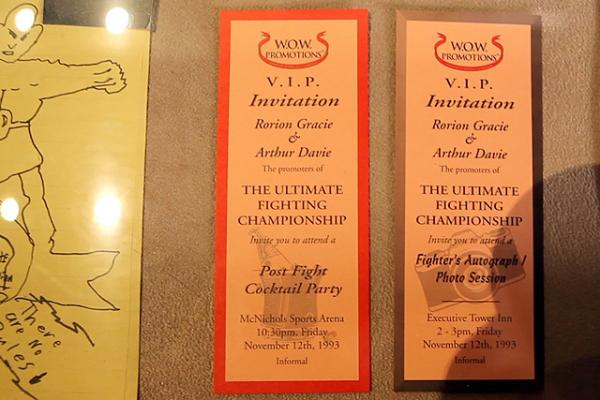Let There Be Fight
A Grand Idea

Royce Gracie's indelible legacy in martial arts began at UFC 1.
| Photo: Dave Mandel/Sherdog.com
America was trapped in a mindset back in the early 1990s, back when no one knew the difference between a sidekick and a dropkick, back when the only references they had to different forms of fighting, other than boxing and professional wrestling, was Daniel-san balancing himself on one leg to do the indefensible crane technique in “The Karate Kid” and a bug-eyed, greased-up Jean-Claude Van Damme flying around in “Bloodsport.”
That was the morass under which mixed martial arts was buried. Otherwise, it was the freakish fringe that followed, holding no crossover appeal, no searing interest of the masses whatsoever. On Nov. 12, 1993, “The Beginning,” changed everything. It tossed out the perception of what real fighting was all about and turned it on its head.
Advertisement
It stirred an age-old debate that had echoed in bars, at ringside and in thousands upon thousands of gyms throughout the world, questioning what fighting discipline was most dominant. Could someone versed in jiu-jitsu beat a world champion boxer? How would a judo expert fair against a wrestler? How would Muhammad Ali do against Bruce Lee in a real fight? Could Bruno Sammartino pin Joe Frazier? Could Ali knock out Sammartino? And so the argument raged.
Some have tried to settle it, like when Gene LeBell
choked out Milo Savage
on Dec. 2, 1963 in the first-ever televised mixed martial arts
match or when Ali stepped into the ring against Japanese pro
wrestling legend Antonio Inoki on June 26, 1976 in Tokyo. That
match turned out to be nothing more than a farce, with Inoki
falling on his back to the canvas and kicking at Ali’s knees for 15
rounds.
By 1990, Davie, an ad executive for J.P. Marketing in Santa Fe Springs, Calif., wanted a little more. The answer to the looming hypothetical pawed at him for years: who could beat whom when it was for real? The year before, Davie read a story in “Playboy” about the amazing Rorion Gracie and the incredible Brazilian fighting family. The Gracies were like the Flying Wallendas, the stunt-walking, high-wire family troupe of daredevils. Only the Gracies specialized with a degree in badass.
Davie, along with Gracie, Hollywood director John Milius and Bob Meyrowitz, the creator of a syndicated radio program called the “King Biscuit Flower Hour,” had a vision and an embryonic view of where it all could lead. Little did they know what they had started. What began as a live infomercial endorsing Gracie Jiu-Jitsu and featuring Royce Gracie would spawn the first Ultimate Fighting Championship event. It dragged into the light mixed martial arts, once considered nothing more than an exhibition fought in garages, private dojos, high school gyms and smoky honkytonks filled with the smell of stale beer, where featured attractions were sometimes held in dog kennels on wrestling mats or makeshift cages with balky boards.
That is where MMA once stood, relegated to irreverence. The UFC converted it from a curious spectacle, filled with 1970s heirlooms of Bruce Lee wannabes, to a sport. It lugged MMA from dimly lit, dusty dungeons into gleaming arenas that filled tens of thousands. It made a nebulous world of tough guys prove how tough they actually were.
Eight fighters of varying abilities and accomplishments were involved. After much rejection and a boatload of angst in getting anyone to listen to their pitch, organizers remained anxious about whether anyone would show up. Despite it all, UFC 1 succeeded.
“I knew all along it was going to be a raging success,” Davie said.
Ask any of the eight fighters from that historic night -- Royce Gracie, boxer Art Jimmerson, shootfighter Ken Shamrock, kickboxer Gerard Gordeau, sumo wrestler Teila Tuli, taekwondo black belt Patrick Smith and kickboxers Zane Frazier and Kevin Rosier -- and they will tell you they had no idea what they were getting themselves into. No one did.
“No one knew what to expect,” Jimmerson said. “No one knew if anyone was going to even show up. The whole thing succeeded, but if people could only see the mess that was going on backstage that night, with no one not really having any idea of what was happening, they would have laughed. I didn’t even know if I was going to get paid.”
Yet, it resulted in triumph, and it all stemmed from a wacky idea and a Brazilian jiu-jitsu artist in search of publicity and someone who was willing to listen to a sales pitch.
“MMA or UFC didn’t exist before what we did,” Rorion said. “You have to go way back to where it used to be. I had hundreds of matches in my garage during a 10-year span. In fact, that is what inspired me to develop the concept for the UFC. Why try to convince one person at a time if I could show it to the world?”

Photo: D.
Mandel/Sherdog.com
Rorion Gracie realized the potential for the UFC to
promote Gracie Jiu-Jitsu.
“Prior to reading the ‘Playboy’ story, I [had] never heard of Rorion Gracie,” Davie said.
“That story gave me a nice bit of biographical information to go on, and I was in the process of looking for anyone who was willing to put on martial arts events. I called Rorion on the phone, cold, out of the blue, and spoke to his wife, Suzanne, and she told me he wasn’t home.”
Still, Davie tracked him down. At the time, Rorion was in the process of moving his garage studio into the new Gracie Jiu-Jitsu Academy in Torrance. When they finally met in person, Rorion’s face said everything. He was pessimistic. He sat there wearing a stone expression, looking away at times, as Davie spoke. His pitch was going in one ear and out the other. Gracie had heard more than his Los Angeles share of I-love-ya-babe-we’ll-make-it-happen stuff. In Rorion’s mind, Davie seemed to be giving him another line of tripe.
“I could tell he had no interest,” Davie said. “He was polite with me, but I could tell I didn’t have his full attention. A lot of people had spoken to Rorion, and so many people had tried speaking to him about doing a tournament. He was a skeptic, but he was made a skeptic. I wore him down. He had been approached and rejected a lot of the bulls--- he was hearing.”
Davie swayed Rorion as much as Gracie swayed Davie, who became a student at the Gracie Jiu-Jitsu Academy and occasionally bent Rorion’s ear about holding an event during idle moments.
“Rorion saw me as a prospective student, and we really took to one another through time,” Davie said. “First of all, I always liked Rorion and there was always a connection there, and I believe there still is to this day. Rorion was always afraid that I was money-motivated and that I would turn into the ‘Art McMahon or the Art Davie version of Vince McMahon.’ Once the familiarity grew, so did the trust, and Rorion was also trying to make money, too.”
The clincher came when Davie suggested a mail-order campaign, hawking videos of Gracie Jiu-Jitsu during the 1991 Christmas season. The promotion garnered $152,000 in cash over the first mailing.
“I had an idea about holding the event and Rorion really didn’t begin listening until we went with his video campaign for Christmas 1991 with the mailings,” Davie said. “I had the impression Rorion had been burnt before, and that’s probably why he was so reluctant about going along about the event at first.”
With Rorion now on board, the hard part came next: to sell Davie’s idea to prospective promoters and money men interested in buying it. Tecate Beer had already rejected Davie, telling him his proposal was too violent.
“Tecate wanted to be associated with something that would attract attention,” Davie said. “They wanted original ideas and Tecate looked at it and rejected it; it was too much for them.”
Ironically, years later, Tecate wound up sponsoring boxing.
In the early 1990s, mixed martial arts already had a number of obstacles stacked against it. For one, no state with an athletic commission sanctioned it. Secondly, it had no television coverage, and no major cable network wanted any part of it. There was no public pressure since, at the time, UFC Nation was a loose coalition of contact sport vagabonds and nomads crawling under rocks. They had no voice cable giants were willing to hear.

Photo: D.
Mandel/Sherdog.com
Eventually, Rorion Gracie and Art Davie formed
an important partnership.
Even so, Davie was not the type who accepts “no” easily. He stayed on them, following up with a personal visit to New York to see the major players in person.
DiBella was staunch with his rebuff, saying “no” in a letter and over the phone, but Davie made it in to see Larkin, who still met with him despite sending a rejection letter.
“Jay said I was a sharp guy and he liked my suit, but if someone came in offering anything mentioning kickboxing or MMA he showed them the door,” Davie said. “I did a presentation with slides and storyboards on the show. They gave us about 55 minutes. After I was done, they said, ‘Art, we still like your suit.’ Then they showed me the door. I told them MMA is coming, and Jay kept saying he’s a boxing guy. Jay [who died of a brain tumor in August 2010] went to his grave saying he didn’t get it. I kept at it. I wrote a business plan and I was knocking on doors. I made cold calls. I didn’t think it was a tough sell.”
What frustrated Davie was the fixed, preconceived notion among the major cable outlets that MMA could not sell. He was receiving denials before he walked through the door. Finally, his two-page fax proposal was accepted by Meyrowitz and the Semaphore Entertainment Group. Meyrowitz was a New York City entrepreneur known for the creation of the “King Biscuit Flower Hour” radio show in the 1970s; he founded SEG in the late 1980s.
Campbell McLaren, general manager and acquisition frontman for Semaphore, jumped right on it, and McLaren did not seem to care about the media backlash, either. In one interview, he told The New York Times: “I was pitched a Saudi Arabian execution. Twice a year, they do heads. We’d do it with a hidden camera. I passed [and] so did Dan Duva.”
SEG was not afraid to take chances. The $14.95 pay-pay-view price was affordable. Prior to dipping into the MMA world, SEG was famously known for the battle of the genders match between tennis legends Jimmy Connors and Martina Navratilova. Putting out names like Connors and Navratilova made it far more palatable for venues to accept, but MMA was different. Would someone bite on this concept of no rules, no weight classes, in an eight-man, single-elimination tournament where the matches can end only by submission, knockout, a corner throwing in the towel or referee stoppage due to a severe injury? Was this the reality version of “Mad Max Beyond Thunderdome,” where two men enter, one man leaves, sans the star power of Gibson scurrying for his life from Master Blaster? Who was going to be open to taking it? Who wanted to watch it? What venue would accept it with open arms? Davie and Rorion’s Gracie’s WOW Promotions, along with Semaphore, found a home at the McNichols Sports Arena in Denver.
“We found a loophole,” Davie said. “Colorado didn’t have a state athletic commission, so we had a place and a state that was willing to welcome us. We knew how many states were against us, and in 1993, they were all against us, so it seemed. We had to find a state without a state athletic commission.”
Continue Reading » A roster of fighters began taking shape, as money proved a powerful allure. A $50,000 check dangling like a carrot on a hook would go to the winner. Each one signed his name to a contract thinking he would be the one taking that check home.
Related Articles






